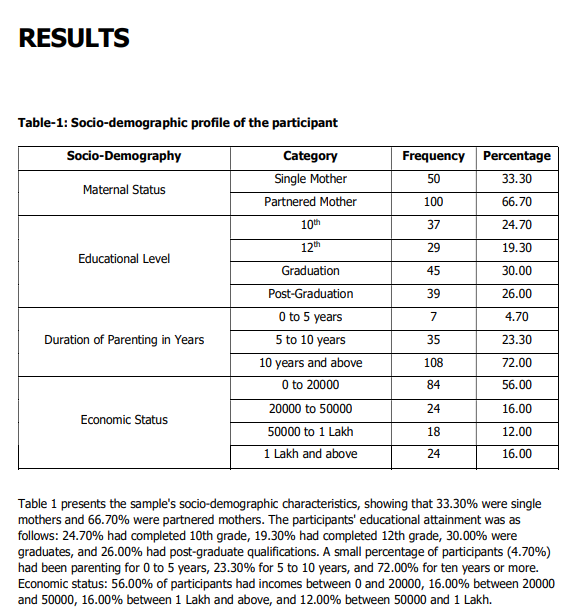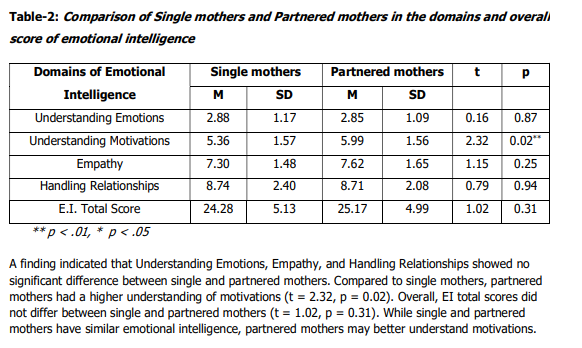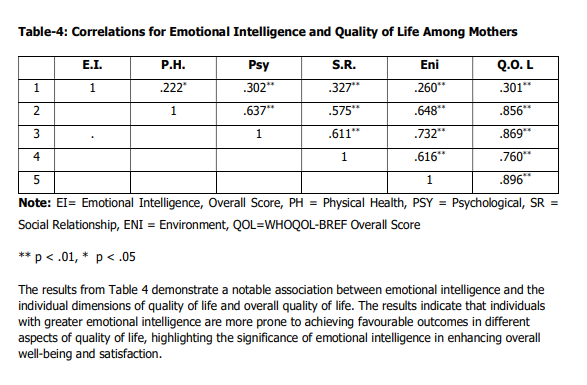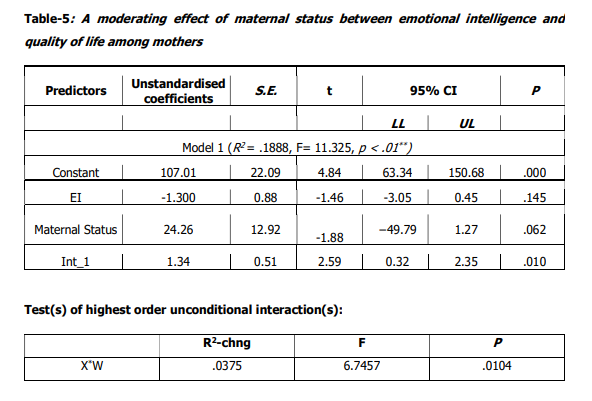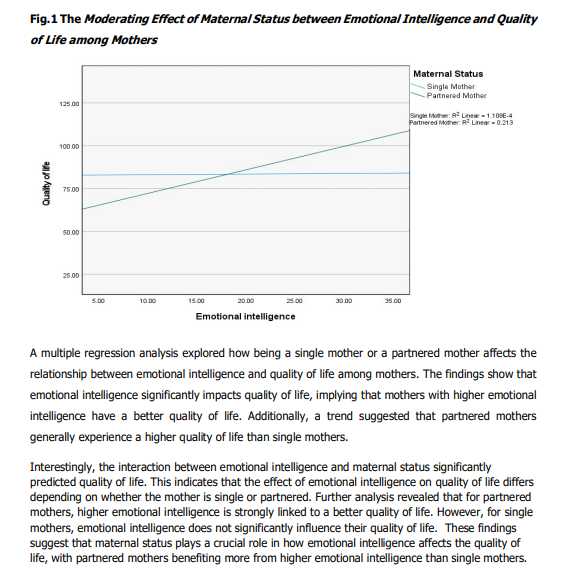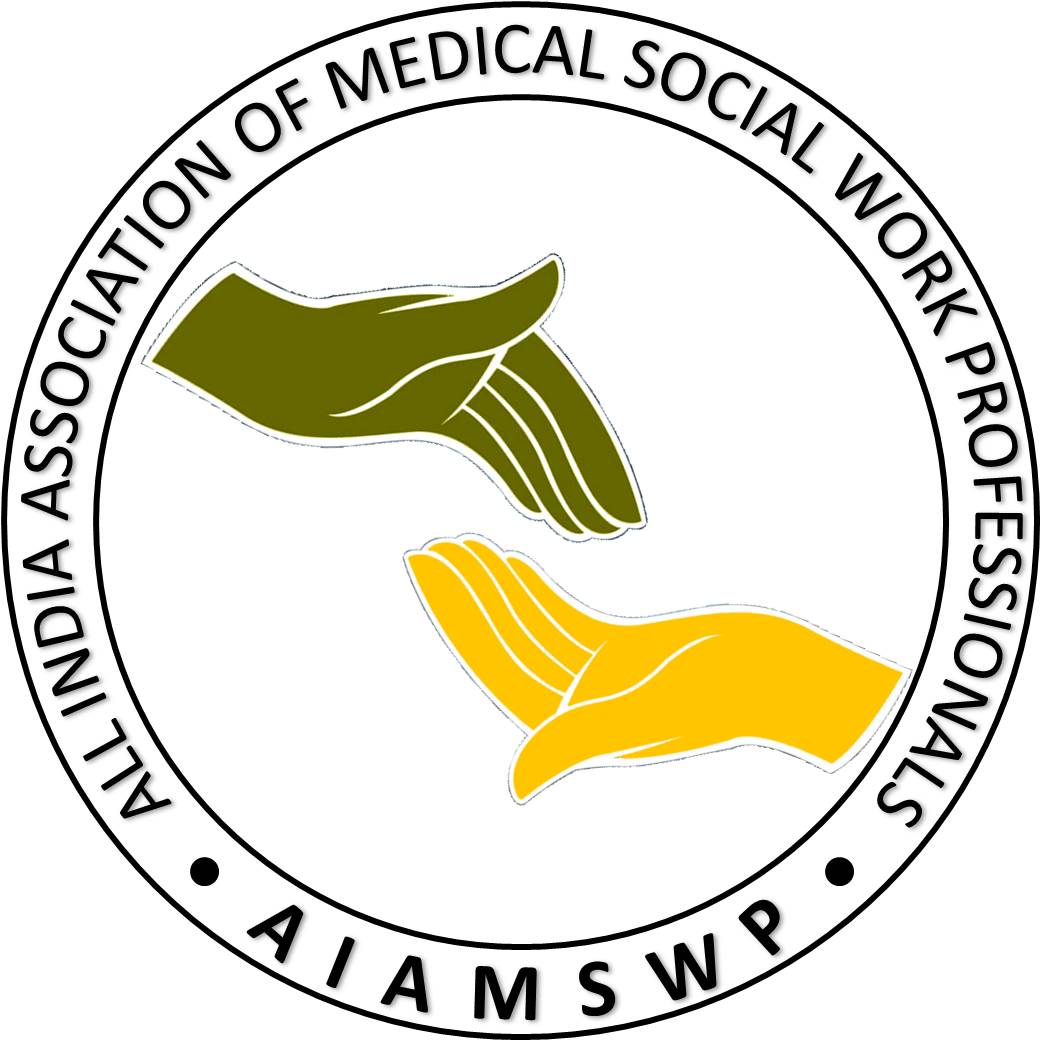Background: The relationship between emotional intelligence and quality of life has been studied
in various populations. However, how maternal status is influenced by maternal status as a
single mother versus a partnered mother has not been thoroughly investigated among mothers.
Aims: The current study examines the moderating role of mother status as a single mother
versus a partnered mother in the relationship between Emotional Intelligence and Quality of Life
in mothers. Method: The research design adopted was cross-sectional and correlational, and a
purposive sampling technique was conducted on a sample of 150 parents from Uttar Pradesh
and the adjacent areas of Bihar. Result: Findings indicate that while single mothers and partnered
mothers do not significantly differ in emotional intelligence domains, partnered mothers report
higher quality of life scores across various domains than single mothers. Moreover, a positive
association is observed between emotional intelligence and quality of life among mothers. Maternal
status moderates this relationship, with a stronger association among partnered mothers.
Conclusion: These results emphasise the importance of considering maternal status in
understanding the complex interplay between emotional intelligence and quality of life among
mothers.
Raising children is an arduous responsibility.
Motherhood is often called the most
challenging and most rewarding job. Having
children gives mothers a sense of purpose and
significance and places many demanding
obligations on them throughout their adult
years (Nomaguchi & Milkie, 2020). The
experience of motherhood involves a wide
range of obstacles and moments of happiness,
which significantly impact both the mothers
and their families’ overall happiness. In
today’s society, the role of mothers has
expanded beyond traditional domestic
responsibilities, with a growing focus on their
emotional intelligence and how it affects their
overall well-being. However, in this complex
network of factors, the impact of being a
parent, whether as a single mother or a
partnered mother, has been identified as an
essential but not extensively studied variable.
In India, the occurrence of single-parent
families varies from 5% to 12%, as reported by Kramer (2019), Pandit (2019), and the U.S.
Census Bureau (2023). Single parents,
especially single mothers, belong to a socially
and economically disadvantaged category that
faces the possibility of experiencing a range
of physical and mental health issues. Single
mothers exhibit inferior physical and mental
well-being compared to parents who reside
together as couples (Rousou et al., 2013).
Emotional intelligence (E.I.) is the capacity to
perceive, comprehend, control accurately, and
proficiently employ emotions within oneself
and about others (Salovey & Sluyter, 1997).
Prior studies have investigated the correlation
between Emotional Intelligence (E.I.) and
different factors, including marital status and
parental roles. A study found that women’s
emotional intelligence level is low (Abdullah
et al., 2019). Nevertheless, a distinct
discovery indicated that solitary fathers
exhibited robust emotional intelligence but
encountered difficulties empathising and
comprehending their adolescent children.
Research also showed that parenting makes
single mothers less happy, sad, stressed, and
tired. However, employed single mothers
report higher levels of emotional well-being
(Meier et al., 2016).
Quality of life (QoL) refers to a thorough and
personal evaluation of an individual’s overall
well-being and contentment with life. It
includes both objective life circumstances and
subjective emotional experiences. The impact
of parents’ quality of life on their well-being,
children’s development, and family dynamics
is significant in the context of parenthood
(Giannakopoulos et al., 2009). Prior research
has indicated that single mothers encounter
a notable decline in their overall quality of
life compared to the broader population (Cook
et al., 2009). Research consistently shows
that single mothers have more mental health
problems and problems balancing work and
family life than mothers who are married
(Dziak, 2010). A recent study by Kim and Kim
(2020) found that married mothers generally
reported a higher quality of life than single
mothers. However, the quality of life of single
mothers by choice is significantly higher than
that of married mothers, even after
controlling for economic and paternal
involvement variables (Segal Engelchin,
2005). Financial hardship and inadequate
resources are key factors contributing to a
reduced perception of quality of life in singlesupporting mothers (Coyne, 2003). These
results suggest that single mothers may face
more significant problems. However, their
quality of life can be affected by many things,
such as their ability to afford things, their
ability to balance work and family life, and
their social support.
This study addresses a critical gap in existing
research by investigating how maternal
status—whether a mother is single or
partnered—moderates the relationship
between emotional intelligence (E.I.) and
quality of life (QoL) among mothers. With the
expanding roles of mothers in society and the
distinct challenges faced by single mothers,
understanding how emotional intelligence
interacts with maternal status to influence
quality of life is vital. By shedding light on this
dynamic, the study can offer insights into
interventions and support systems tailored to
different maternal statuses, ultimately
enhancing the well-being of mothers and their
families.
This study employs a cross-sectional and
correlational research design, utilising a
survey methodology with questionnaires as the
primary data collection tool. A purposive
sampling technique was utilised to select 150
mothers (50 single mothers and 100 partnered
mothers) from Uttar Pradesh and adjacent
parts of Bihar. The sample selection followed
specific criteria for inclusion and exclusion.
Inclusion criteria
Study Measures
Personal and Socio Demographical Data Sheet was used to obtain information about
the participants’ sociodemographic
characteristics, including age, gender,
education, area of habitat, state, parenting
status, Duration of Parenting in Years,
monthly income, source of income, area of
habitat, number of children and social support
system.
WHO Quality of Life (QOL) BREF scale
(1995)- Hindi Version is a widely utilised
questionnaire designed to evaluate an
individual’s subjective perception of their
quality of life. It comprises 26 items that
assess four domains: physical health,
psychological health, social relationships, and
environment. Research has consistently
demonstrated the high reliability of this scale,
with internal consistency coefficients ranging
from 0.70 to 0.90 for each domain. Testretest reliability coefficients have been
reported to range from 0.69 to 0.80,
suggesting that the questionnaire yields
consistent results over time (World Health
Organization, 1995). Moreover, the WHOQOLBREF scale exhibits good construct validity,
with each domain capturing a distinct quality
of life. Additionally, it demonstrates good
convergent validity, displaying substantial
correlations with other measures of quality
of life and related constructs (World Health
Organization, 1995).
Emotional Intelligence Scale: This scale
was developed by Arun Kumar Singh and
Shruti Narain in 2014, is a self-report
questionnaire designed to assess emotional
intelligence across four dimensions: (a)
Understanding Emotions, (b) Understanding
Motivation, (c) Empathy, and (d) Handling
Relations. The scale consists of 31 items rated
on a two-point scale. Emotional Intelligence
Scale test-retest reliability was ± = 0.86, statistically significant at the p <.01.
Additionally, the concurrent validity of the
scale was established at á = 0.86, also
significant at the p < .01 level (Singh &
Narain, 2014).
Procedure of data collection
A sample was collected strictly following all
inclusion and exclusion criteria. Before
collecting data from the participants, their
informed consent was acquired, a robust
rapport was established, and the ethical
guidelines outlined by the APA were followed.
Sociodemographic data were collected during
the initial phase, while selected tools were
administered during the subsequent phase,
according to the subject’s convenience.
Statistical Analysis
The data was analysed using statistical
methods such as T-test, Correlation, and
Moderation analysis. The analysis was
performed utilising Statistical Package for
Social Sciences (SPSS) version 25 and
Process Macro software.
The findings of this study offer valuable
insights into the distinct experiences of single
mothers and partnered mothers concerning
emotional intelligence (E.I.) and quality of life
(QOL), as well as the potential moderating
role of maternal status in the relationship
between E.I. and QOL. Firstly, concerning the
components of emotional intelligence, our
results indicate that while single mothers and
partnered mothers do not significantly differ
in their understanding of emotions, empathy,
and handling relationships, partnered
mothers demonstrate a higher understanding
of motivations than single mothers. This
finding is consistent with prior research that
women’s emotional intelligence level is low
(Abdullah et al., 2019). The finding suggests
that regardless of maternal status, women
face common challenges in emotional
intelligence.
Regarding quality of life, partnered mothers
consistently reported higher scores across
various domains than single mothers,
including physical health, psychological wellbeing, social relationships, environmental
factors, and overall QOL. These findings align
with previous studies that showed married
mothers generally report a higher QOL than
single mothers (Kim & Kim, 2020). However,
it is interesting to note that the quality of life
of single mothers by choice is significantly
higher than that of married mothers, even
after controlling for economic and paternal
involvement variables (Segal Engelchin,
2005). Findings highlight the complexity of
factors influencing QOL among mothers,
including personal choices and circumstances.
Furthermore, our correlation analysis reveals
a positive association between emotional
intelligence and quality of life among mothers,
consistent with prior research (Alibakhshi et
al., 2018; Ebeid et al., 2021; Maharaj &
Ramsaroop, 2022). This emphasises the
importance of emotional intelligence in
promoting overall well-being and satisfaction
in several areas of life.
Importantly, our study also explores the
moderating effect of maternal status on the
relationship between emotional intelligence
and quality of life. The results suggest that
while emotional intelligence is positively
associated with quality of life among
partnered mothers, this relationship is
insignificant among single mothers. The
finding indicates that the impact of emotional
intelligence on quality of life may be influenced
by maternal status, with emotional
intelligence being more strongly related to
quality of life among partnered mothers than
single mothers. In conclusion, these findings
emphasise the necessity of customised
interventions and support systems to tackle
single mothers’ distinct challenges in
improving their emotional intelligence and
overall quality of life. Additionally, future
research could delve deeper into
understanding the specific mechanisms
through which emotional intelligence
influences the quality of life among mothers,
taking into account various contextual factors
such as socioeconomic status and cultural
norms.
In conclusion, this study points out the unique
experiences of single mothers and partnered
mothers concerning E.I. and QOL. Partnered
mothers show higher levels of understanding
motivations and overall quality of life than
single mothers. Furthermore, a positive
relationship between E.I. and QOL for mothers
identifies the significance of emotional
intelligence in enhancing well-being.
Importantly, maternal status moderates the
relationship between E.I. Interestingly, this
was more strongly linked to QOL among
mothers who were partnered. These findings
underline the need for tailored support
interventions to enhance emotional
intelligence and quality of life, particularly
among single mothers, in promoting overall
well-being.
Abdullah, S. S. B., Kosnin, A., & Jiar, Y. K.
(2019). Emotional Intelligence Among
Women: A Systematic Review.
International Journal of Engineering
and Advanced Technology, 8(5c), 967–
970. https://doi.org/10.35940/
ijeat.E1137.0585C19
Alibakhshi, H., Mahdizadeh, F., Siminghalam,
M., & Ghorbani, R. (2018). The Effect
of Emotional Intelligence on the
Quality of Life of Mothers of Children
with Autism. Middle East Journal of
Rehabilitation and Health, 5(1). https:/
/doi.org/10.5812/mejrh.12468
Cook, K., Davis, E., Smyth, P., & McKenzie, H.
(2009). The Quality of Life of Single
Mothers Making the Transition from
Welfare to Work. Women & Health,
49(6–7), 475–490. https://doi.org/
10.1080/03630240903423980
Coyne, G. (2003). An investigation of coping
skills and quality of life among single
sole supporting mothers. International
Journal of Anthropology, 18(3), 127–
138. https://doi.org/10.1007/
BF02447541
Dziak, E., Janzen, B. L., & Muhajarine, N.
(2010). Inequalities in the
psychological well-being of employed,
single and partnered mothers: The
role of psychosocial work quality and
work-family conflict. International
Journal for Equity in Health, 9(1), 6.
https://doi.org/10.1186/1475-9276-9-
6
Ebeid, I., Elneblawi, N., Abdmaqsoud, A.,
Elshatarat, R., & Elkazaz, R. (2021).
The Association Between Emotional
Intelligence, Quality of Life and the
Burden among Mothers of Children
with Autism Spectrum Disorder. Assiut
Scientific Nursing Journal, 9(26.), 10–
20. https://doi.org/10.21608/
asnj.2021.92850.1228
Giannakopoulos, G., Dimitrakaki, C., Pedeli, X.,
Kolaitis, G., Rotsika, V., RavensSieberer, U., & Tountas, Y. (2009).
Adolescents’ wellbeing and
functioning: Relationships with
parents’ subjective general physical
and mental health. Health and Quality
of Life Outcomes, 7(1), 100. https://
doi.org/10.1186/1477-7525-7-100
Kim, G. E., & Kim, E.-J. (2020). Factors
affecting the quality of life of single
mothers compared to married
mothers. BMC Psychiatry, 20(1), 169.
https://doi.org/10.1186/s12888-020-
02586-0
Kramer, S. (2019). U.S. has world’s highest
rate of children living in single-parent
households. Pew Research Center,
Washington, D.C. https://
www.pewresearch.org/short-reads/
2019/12/12/u-s-children-more-likelythan-children-in-other-countries-tolive-with-just-one-parent/
Maharaj, P., & Ramsaroop, A. (2022).
Emotional intelligence as a contributor to enhancing educators’ quality of life
in the COVID-19 era. Frontiers in
Psychology, 13, 921343. https://
doi.org/10.3389/fpsyg.2022.921343
Meier, A., Musick, K., Flood, S., & Dunifon, R.
(2016). Mothering Experiences: How
Single Parenthood and Employment
Structure the Emotional Valence of
Parenting. Demography, 53(3), 649–
674. https://doi.org/10.1007/s13524-
016-0474-x
Nomaguchi, K., & Milkie, M. A. (2020).
Parenthood and Well Being: A Decade
in Review. Journal of Marriage and
Family, 82(1), 198–223. https://
doi.org/10.1111/jomf.12646
Pandit, A. (2019, June 26). Single mothers
head 4.5% of all Indian households.
THE TIMES OF INDIA. https://
timesofindia.indiatimes.com/india/unreport-13-million-households-in-indiawhere-lone-mothers-live-alone-withchildren/articleshow/69949845.cms
Rousou, E., Kouta, C., Middleton, N., &
Karanikola, M. (2013). Single mothers’
self-assessment of health: A
systematic exploration of the
literature: Single mothers’ health.
International Nursing Review, 60(4),
425–434. https://doi.org/10.1111/
inr.12044
Salovey, P., & Sluyter, D. J. (Eds.). (1997).
Emotional development and emotional
intelligence: Educational implications
(1st ed). Basic Books. https://
psycnet.apa.org/record/1997-08644-
000
Segal-Engelchin, D., & Wozner, Y. (2005).
Quality of Life of Single Mothers by
Choice in Israel: A Comparison to
Divorced Mothers and Married
Mothers. Marriage & Family Review,
37(4), 7–28. https://doi.org/10.1300/
J002v37n04_02
U.S. Census Bureau. (2023, March 21).
National Single Parent Day: March 21,
2023. The Census Bureau. https://
www.census.gov/newsroom/stories/
single-parent-day.html
